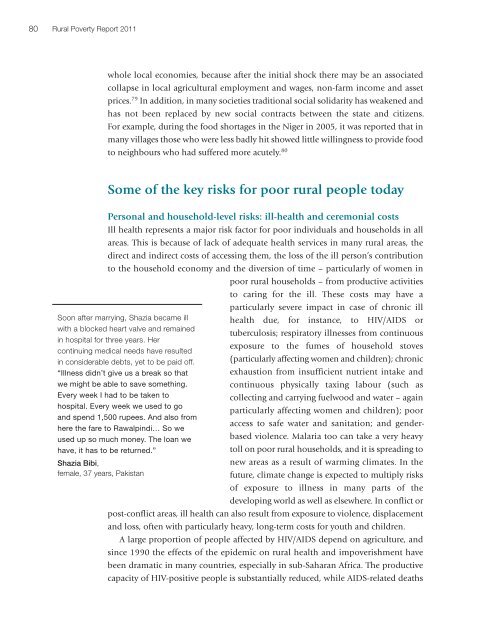English - IFAD
English - IFAD
English - IFAD
Create successful ePaper yourself
Turn your PDF publications into a flip-book with our unique Google optimized e-Paper software.
80<br />
Rural Poverty Report 2011<br />
whole local economies, because after the initial shock there may be an associated<br />
collapse in local agricultural employment and wages, non-farm income and asset<br />
prices. 79 In addition, in many societies traditional social solidarity has weakened and<br />
has not been replaced by new social contracts between the state and citizens.<br />
For example, during the food shortages in the Niger in 2005, it was reported that in<br />
many villages those who were less badly hit showed little willingness to provide food<br />
to neighbours who had suffered more acutely. 80<br />
Some of the key risks for poor rural people today<br />
Personal and household-level risks: ill-health and ceremonial costs<br />
Ill health represents a major risk factor for poor individuals and households in all<br />
areas. This is because of lack of adequate health services in many rural areas, the<br />
direct and indirect costs of accessing them, the loss of the ill person’s contribution<br />
to the household economy and the diversion of time – particularly of women in<br />
poor rural households – from productive activities<br />
to caring for the ill. These costs may have a<br />
particularly severe impact in case of chronic ill<br />
Soon after marrying, Shazia became ill<br />
with a blocked heart valve and remained<br />
in hospital for three years. Her<br />
continuing medical needs have resulted<br />
in considerable debts, yet to be paid off.<br />
“Illness didn’t give us a break so that<br />
we might be able to save something.<br />
Every week I had to be taken to<br />
hospital. Every week we used to go<br />
and spend 1,500 rupees. And also from<br />
here the fare to Rawalpindi… So we<br />
used up so much money. The loan we<br />
have, it has to be returned.”<br />
Shazia Bibi,<br />
female, 37 years, Pakistan<br />
health due, for instance, to HIV/AIDS or<br />
tuberculosis; respiratory illnesses from continuous<br />
exposure to the fumes of household stoves<br />
(particularly affecting women and children); chronic<br />
exhaustion from insufficient nutrient intake and<br />
continuous physically taxing labour (such as<br />
collecting and carrying fuelwood and water – again<br />
particularly affecting women and children); poor<br />
access to safe water and sanitation; and genderbased<br />
violence. Malaria too can take a very heavy<br />
toll on poor rural households, and it is spreading to<br />
new areas as a result of warming climates. In the<br />
future, climate change is expected to multiply risks<br />
of exposure to illness in many parts of the<br />
developing world as well as elsewhere. In conflict or<br />
post-conflict areas, ill health can also result from exposure to violence, displacement<br />
and loss, often with particularly heavy, long-term costs for youth and children.<br />
A large proportion of people affected by HIV/AIDS depend on agriculture, and<br />
since 1990 the effects of the epidemic on rural health and impoverishment have<br />
been dramatic in many countries, especially in sub-Saharan Africa. The productive<br />
capacity of HIV-positive people is substantially reduced, while AIDS-related deaths

















